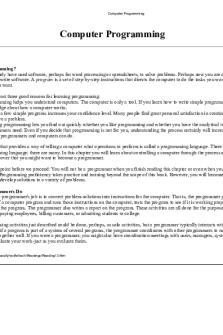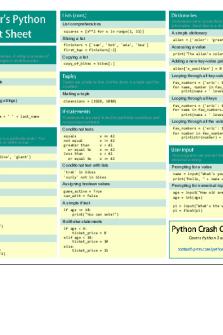Introduction to Programming in Python PDF

| Title | Introduction to Programming in Python |
|---|---|
| Author | Sanjay Kumar |
| Course | PYTHON |
| Institution | Lovely Professional University |
| Pages | 63 |
| File Size | 901.7 KB |
| File Type | |
| Total Downloads | 85 |
| Total Views | 149 |
Summary
Download Introduction to Programming in Python PDF
Description
Department of Physics
Introduction to Programming in Python
A Self-Study Course (Version 2.2 – October 2009)
Table of Contents 1
Chapter 1 - Introduction.....................................................................................................6
2
Chapter 2 - Resources Required for the Course.................................................................8
3
2.1
Programming Language.............................................................................................8
2.2
Computer Operating Systems ....................................................................................8
2.3
Additional Libraries (Modules) .................................................................................8
2.4
Editors ........................................................................................................................9
2.5
Where to do the Work................................................................................................9
2.6
Books .......................................................................................................................10
Chapter 3 - Getting Started ..............................................................................................11 3.1
Numbers...................................................................................................................11
3.2
Assignments, Strings and Types ..............................................................................12
3.2.1
A First Mention of Functions...........................................................................14
3.2.2
A Brief Mention of Methods............................................................................14
3.3
Complex numbers (Advanced Topic).......................................................................15
3.4
Errors and Exceptions ..............................................................................................15
3.5
Precision and Overflow............................................................................................16
3.5.1
Precision...........................................................................................................16
3.5.2
Overflow – Large Numbers .............................................................................17
3.6 4
Chapter 4 - Input and Output (IO) ...................................................................................18 4.1
Screen Input/Output .................................................................................................18
4.1.1
Output ..............................................................................................................18
4.1.2
The Format Conversion Specifier....................................................................18
4.1.3
Special Characters in Output ...........................................................................19
4.1.4
Input .................................................................................................................19
4.2
5
Getting Help.............................................................................................................17
File Input and Output ..............................................................................................20
4.2.1
Saving an Array to File ....................................................................................20
4.2.2
Loading an Array from File .............................................................................21
Chapter 5 - Programs (Scripts) ........................................................................................22 5.1
My First Program – ‘Hello world’ ...........................................................................22
5.2
Exercises ..................................................................................................................22
5.2.1
Exercise 5.1......................................................................................................22
5.2.2
Exercise 5.2......................................................................................................23
Page 2 of 63
6
Chapter 6 - Sequences, Lists and Strings.........................................................................24 6.1
7
6.1.1
Slicing Lists .....................................................................................................25
6.1.2
2-d Lists ...........................................................................................................26
6.1.3
Basic List Operations.......................................................................................26
6.1.4
Fancy List Handling – zip() and map() – Advanced Topic .............................27
6.1.5
Tuples...............................................................................................................28
6.2
Strings ......................................................................................................................28
6.3
Numpy arrays – An Introduction .............................................................................29
6.3.1
Using NumPy...................................................................................................30
6.3.2
Addressing and Slicing Arrays ........................................................................30
6.4
Dictionaries – Advanced Topic ................................................................................31
6.5
Exercises ..................................................................................................................32
6.5.1
Exercise 6.1 - Lists...........................................................................................32
6.5.2
Exercise 6.3 – Arrays.......................................................................................32
6.5.3
Exercise 6.2 – Dictionaries - Advanced Topic .................................................33
Chapter 7 - Conditionals and Loops ................................................................................34 7.1
Conditionals .............................................................................................................34
7.2
Loops........................................................................................................................35
7.2.1
Loops - The ‘while’ loop .................................................................................36
7.2.2
Loops – The ‘for’ loop.....................................................................................36
7.2.3
Getting out of Infinite Loops - break ...............................................................37
7.3
8
Lists..........................................................................................................................24
Exercises ..................................................................................................................37
7.3.1
Exercise 7.1......................................................................................................37
7.3.2
Exercise 7.2......................................................................................................37
7.3.3
Exercise 7.3......................................................................................................38
Chapter 8 - Functions and Modules .................................................................................39 8.1
A First Function .......................................................................................................39
8.1.1
Default values for parameters in a function.....................................................40
8.1.2
Documentation Strings.....................................................................................40
8.2
Returning more than one value ................................................................................41
8.3
Modules and import .................................................................................................41
8.3.1
Import...............................................................................................................41
8.3.2
from import ..................................................................42
8.3.3
import as ...........................................................................42
Page 3 of 63
8.3.4
Allowing Python to find your Modules ...........................................................43
8.3.5
What’s in a Module?........................................................................................43
8.3.6
Testing Functions and Modules .......................................................................44
8.3.7
pyc Files ...........................................................................................................45
8.4
9
Exercises ..................................................................................................................45
8.4.1
Exercise 8.1......................................................................................................45
8.4.2
Exercise 8.2......................................................................................................45
8.4.3
Exercise 8.3......................................................................................................45
8.4.4
Exercise 8.4......................................................................................................46
8.4.5
Exercise 8.5......................................................................................................46
Chapter 9 - Debugging and Exceptions ...........................................................................47 9.1
Using print for debugging ...................................................................................47
9.2
Use the Command Line ...........................................................................................47
9.3
Module Test Code....................................................................................................47
9.4
Handling Exceptions: try / except – Advanced Topic ..............................................47
9.4.1
Catching ALL Exceptions................................................................................47
9.4.2
Catching Specific Exceptions ..........................................................................48
9.5
Exercises ..................................................................................................................49
9.5.1 10
Exercise 9.1 – Advanced Topic ........................................................................49
Chapter 10 - Maths Modules: NumPy .........................................................................51
10.1
The math Module.....................................................................................................51
10.2
The NumPy Module.................................................................................................51
10.2.1
Creating Arrays and Some Examples of Basic Manipulation .........................51
10.2.2
Linear Algebra .................................................................................................54
10.3
The SciPy Module – Advanced Topic......................................................................55
10.4
Exercises ..................................................................................................................55
10.4.1
Exercise 10.1....................................................................................................55
10.4.2
Exercise 10.2....................................................................................................55
11
Chapter 11 - File Input and Output – The Details .......................................................57
11.1
Line Terminators – The \n character........................................................................57
11.2
Writing to File..........................................................................................................57
11.3
Reading from File ....................................................................................................58
11.4
Exercises ..................................................................................................................59
11.4.1
Exercise 11.1....................................................................................................59
11.4.2
Exercise 11.2....................................................................................................59
Page 4 of 63
11.4.3
Exercise 11.3....................................................................................................59
11.4.4
Exercise 11.4....................................................................................................59
12
Chapter 12 - Plotting Graphs .......................................................................................60
12.1
PyLab: The absolute Basics .....................................................................................60
12.2
GUIs – How do they work? .....................................................................................61
12.3
Exercises ..................................................................................................................62
12.3.1 13
Exercise 12.1....................................................................................................62
Chapter 13 - Random Numbers ...................................................................................63
13.1
Exercises ..................................................................................................................63
13.1.1
Exercise 13.1....................................................................................................63
Page 5 of 63
1 Chapter 1 - Introduction The aim of this course is to introduce you to the development of computer programs and to provide you with a working knowledge of the Python language. In addition to everyday usage, physicists use computers for: •
Controlling apparatus and taking readings automatically – EG using LabView
•
Processing data to extract conclusions
•
Predicting the results of experiments
•
Simulations of systems that are too complex to describe analytically
All but the first of these generally require using a computer programming language. The latter two can be described as ‘Computational Physics’. There are computer ‘applications’ that allow you to address some of these problems – you will already have used Excel extensively. However, to obtain the flexibility to solve a particular problem the way YOU want to do it, you must write your own dedicated ‘application’ using a computer programming language. Thus skills in programming are extremely important to the modern physicist. They will be essential to you in later stages of your degree. This course provides you with an introduction to programming that should enable you to develop the more extensive skills required in this and later years. Such skills are also much sought after by a wide variety of employers. There are many programming languages and much argument over which is ‘best’. The skills that you acquire in this course should be easily transferable from the Python language that you will use to other languages. When preparing a course such as this, there is always a decision to be made over which programming language to use: in this case we have chosen Python, a relatively new (dating from 1990) but widely used language. Although not originally designed for scientific use, it is a powerful modern language, easy to learn and ideal for the rapid development of programs. Python is widely used. For example, the installation scripts for many Linux distributions are written in Python, as is the BitTorrent software. Google uses Python extensively, as do AstraZeneca, the pharmaceutical company, and Industrial Light and Magic, the company behind the special effects for Star Wars and many subsequent movies. Python is interpreted, which means that the computer runs another program to read your input and then execute your instructions. Programs written in languages like FORTRAN or C++ are compiled, meaning that the computer translates them into a more basic machine-readable form which can be executed much faster. The speed disadvantage of interpreting will not be an issue in this course. In fact, not having to compile and link your code before running it will save you considerable time. Nevertheless, you should be aware of this fundamental difference between interpreted and compiled languages. Python’s high-level language features also mean that programs will typically be much shorter than equivalent ones written in C or C++. Python can be linked to compiled code from other languages, which can largely get over the speed penalty. This is done, for example, in the NumPy and SciPy modules which we’ll encounter during this course. They provide fast vector and matrix handling, as well as Python interfaces to fast routines for tasks like integration, solving differential equations and linear algebra. If you become a Python expert, you’ll be able to make links to your own compiled code.
Page 6 of 63
Whilst one can use Python, rather like a powerful programmable editor, from the command line, you will soon want to write many lines of program and save them to a file. You then tell Python to execute the file. For this you need an editor. You can use any ordinary text editor (NOT a work processor!!). There is a very good editor bu...
Similar Free PDFs

Introduction to C - programming
- 4 Pages

Programming with python-3
- 82 Pages

Computer Programming python
- 15 Pages

Lab04 - Python Programming.
- 11 Pages
Popular Institutions
- Tinajero National High School - Annex
- Politeknik Caltex Riau
- Yokohama City University
- SGT University
- University of Al-Qadisiyah
- Divine Word College of Vigan
- Techniek College Rotterdam
- Universidade de Santiago
- Universiti Teknologi MARA Cawangan Johor Kampus Pasir Gudang
- Poltekkes Kemenkes Yogyakarta
- Baguio City National High School
- Colegio san marcos
- preparatoria uno
- Centro de Bachillerato Tecnológico Industrial y de Servicios No. 107
- Dalian Maritime University
- Quang Trung Secondary School
- Colegio Tecnológico en Informática
- Corporación Regional de Educación Superior
- Grupo CEDVA
- Dar Al Uloom University
- Centro de Estudios Preuniversitarios de la Universidad Nacional de Ingeniería
- 上智大学
- Aakash International School, Nuna Majara
- San Felipe Neri Catholic School
- Kang Chiao International School - New Taipei City
- Misamis Occidental National High School
- Institución Educativa Escuela Normal Juan Ladrilleros
- Kolehiyo ng Pantukan
- Batanes State College
- Instituto Continental
- Sekolah Menengah Kejuruan Kesehatan Kaltara (Tarakan)
- Colegio de La Inmaculada Concepcion - Cebu











